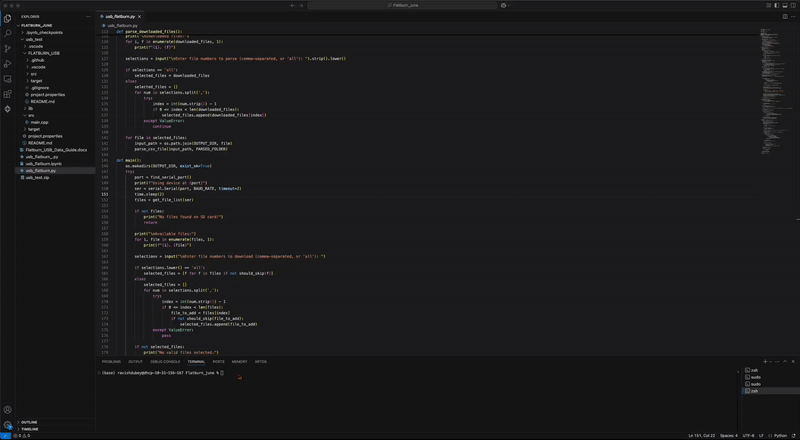📊 Data retrieval via USB cable
Follow these steps to retrieve data from the Flatburn device using the python script.
The Python script to use is here
A sample demo of how to retrieve the data via USB

Step 1: Connect Flatburn to Your Computer
Turn on your Flatburn device.
Use a USB cable to connect the device to your computer.
Step 2: Run the USB Data Script
For Mac/Linux:
Open your terminal and navigate to the folder where the usb_flatburn.py is saved: cd path\to\your\script
run the script with admin permissions
sudo python usb_flatburn.py
You will be prompted to enter your password to continue.
For Windows:
Open Command Prompt or PowerShell as Administrator:
Press Start, search for “cmd” or “powershell”.
Right-click and choose “Run as administrator”.
Navigate to the folder where usb_flatburn.py is saved:
Run the script using Python:
python usb_flatburn.py
Step 3: Select the USB Port
The script will show a list of available serial ports:
Available serial ports:
- /dev/cu.xx - n/a
- /dev/cu.xx - n/a
- /dev/cu.xx - n/a
- /dev/cu.usbmodem3101 - B-SoM CDC Mode
Enter the number of the port to use:
Identify the Flatburn port (usually says "CDC Mode") and enter the corresponding number (e.g., 4).
Step 4: Choose Files to Download
The script will show the available files on the SD card, for ex:
Available files:
- /12052114.CSV
- /12052130.CSV
- /12061515.CSV
You’ll be prompted to select which files to download:
Enter file numbers to download (comma-separated, or 'all')
To download all files: type: all
To download specific files, type their numbers (e.g., 3):
You'll the see the prompt display:
Downloading /12061515.CSV
Saved: /Users/user/sd_card_downloads/12061515.CSV (63448 bytes)
Files are saved to the folder: ~/sd_card_downloads/
Step 5: Choose Files to Parse
Once files are downloaded, you'll see: Downloaded files:
- 12052114.CSV
- 12052130.CSV
- 12061515.CSV
You’ll be prompted to select which files to parse (i.e., clean and format for analysis):
Enter file numbers to parse (comma-separated, or 'all'):
To parse all downloaded files: type: all
To parse specific files, type their numbers (e.g., 3):
You'll the see the prompt display:
Parsed and saved: /Users/user/sd_card_downloads/parsed_files/12061515_parsed.csv
Parsed files will be saved to: ~/sd_card_downloads/parsed_files/
Each file is saved with a _parsed.csv suffix.
Step 6: You're Done!
You now have clean, ready-to-use CSV files containing environmental and telemetry data. You can now use these files for analysis, upload to cloud storage, or integrate them into your research workflow.